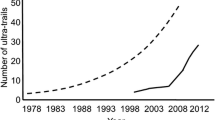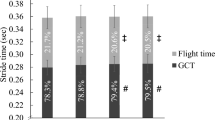Abstract
Purpose
We sought to biomechanically distinguish steep uphill running from steep uphill walking and explore why athletes alternate between walking and running on steep inclines.
Methods
We quantified vertical center of mass (COM) accelerations and basic stride parameters for both walking and running at a treadmill speed of 1.0 m/s on the level and up a 30° incline. We also investigated how electromyography (EMG) of the gluteus maximus (GMAX), vastus medialis (VM), medial gastrocnemius (MG), and soleus (SOL) muscles differ between gaits when ascending steep hills.
Results
The vertical COM accelerations for steep uphill walking exhibited two peaks per step of magnitude 1.47 ± 0.23 g and 0.79 ± 0.10 g. In contrast, steep running exhibited a single peak per step pattern with a magnitude of 1.81 ± 0.15 g. Steep uphill running exhibited no aerial phase, 40% faster stride frequency, and 40% shorter foot–ground contact time compared to steep uphill walking but similar leg swing times. SOL showed 36% less iEMG per stride during steep uphill running versus steep uphill walking, but all other EMG comparisons between steep running and walking were not significantly different.
Conclusions
Multiple biomechanical variables clearly indicate that steep uphill running is a distinctly different gait from steep uphill walking and is more similar to level running. The competing desires to minimize the energetic cost of locomotion and to avoid exhaustion of the SOL may be a possible explanation for gait alternation on steep inclines.
Similar content being viewed by others
Abbreviations
- BW:
-
Body weight
- COM:
-
Center of mass
- EMG:
-
Electromyography
- g :
-
Gravitational acceleration (= 9.81 m/s2)
- GMAX:
-
Gluteus maximus
- iEMG:
-
integrated EMG
- IMU:
-
Inertial measurement unit
- MG:
-
Medial gastrocnemius
- PTS:
-
Preferred transition speed
- SOL:
-
Soleus
- VK:
-
Vertical kilometer race
- VM:
-
Vastus medialis
References
Abe D, Fukuoka Y, Horiuchi M (2019) Why do we transition from walking to running? Energy cost and lower leg muscle activity before and after gait transition under body weight support. PeerJ. https://doi.org/10.7717/peerj.8290
Alexander RM (1984) The gaits of bipedal and quadrupedal animals. Int J Robot Res 3(2):49–59
Alexander RM (1989) Optimization of gaits in the locomotion of vertebrates. Physiol Rev 69(4):1199–1227
Bartlett JL, Kram R (2008) Changing the demand on specific muscle groups affects the walk-run transition speed. J Exp Biol 211:1281–1288
Cavagna GA, Heglund NC, Taylor CR (1977) Mechanical work in terrestrial locomotion: two basic mechanisms for minimizing energy expenditure. Am J Physiol 233(5):R243–R261
Cavagna GA, Saibene FP, Margaria R (1963) External work in walking. J Appl Physiol 18(1):1–9
Cavagna GA, Saibene FP, Margaria R (1964) Mechanical work in running. J Appl Physiol 19(2):249–256
Cavanagh P, Lafortune M (1980) Ground reaction forces in distance running. J Biomech 13:397–406
Cram JF, Kasman GS (1998) Introduction to surface to electromyography. Aspen Publishing, Gaithersburg
DeVita P (1994) The selection of a standard convention for analyzing gait data based on the analysis of relevant biomechanical factors. J Biomech 27:501–508
Farley CT, Ferris DP (1998) Biomechanics of walking and running: center of mass movements to muscle action. Exerc Sport Sci Rev 26(1):253–286
Franz JR, Kram R (2013) Advanced age affects the individual leg mechanics of level, uphill, and downhill walking. J Biomech 46:535–540
Franz JR, Kram R (2014) Advanced age and the mechanics of uphill walking: a joint-level, inverse dynamic analysis. Gait Posture 39(1):135–140
Giovanelli N, Ortiz ALR, Henninger K, Kram R (2015) Energetics of vertical kilometer foot races; is steeper cheaper? J Appl Physiol 120:370–375
Giovanelli N, Sulli M, Kram R, Lazzer S (2019) Do poles save energy during steep uphill walking? Eur J Appl Physiol 119(7):1557–1563
Gottschall JS, Kram R (2005) Ground reaction forces during downhill and uphill running. J Biomech 38(3):445–452
Gottschall JS, Kram R (2006) Mechanical energy fluctuations during hill walking: the effects of slope on inverted pendulum exchange. J Exp Biol 209(24):4895–4900
Gurchiek RD, McGinnis RS, Needle AR, McBride JM, van Werkhoven H (2017) The use of a single inertial sensor to estimate 3-dimensional ground reaction force during accelerative running tasks. J Biomech 61:263–268
Hamner SR, Seth A, Delp SL (2010) Muscle contributions to propulsion and support during running. J Biomech 43(14):2709–2716
Hreljac A, Arata A, Ferber R, Mercer JA, Row BS (2001) An electromyographical analysis of the role of dorsiflexors on the gait transition during human locomotion. J Appl Biomech 17:287–296
McMahon TA, Valiant G, Frederick EC (1987) Groucho running. J Appl Physiol 62(6):2326–2337
McMahon TA, Cheng GC (1990) The mechanics of running: how does stiffness couple with speed? J Biomech 23:65–78
Nilsson J, Thorstensson A, Halbertsma J (1985) Changes in leg movements and muscle activity with speed of locomotion and mode of progression in humans. Acta Physiol Scand 123:457–475
Nilsson J, Thorstensson A (1987) Adaptability in frequency and amplitude of leg movement during human locomotion at different speeds. Acta Physiol Scand 129:107–114
Ortiz ALR, Giovanelli N, Kram R (2017) The metabolic costs of walking and running up a 30-degree incline: implications for vertical kilometer foot races. Eur J Appl Physiol 117:1869–1876
Snyder KL, Kram R, Gottschall JS (2012) The role of elastic energy storage and recovery in downhill and uphill running. J Exp Biol 215(13):2283–2287
Acknowledgements
We thank Dr. Alena Grabowski for the use of equipment and Dr. Wouter Hoogkamer for his insights and help with MATLAB.
Author information
Authors and Affiliations
Contributions
CW, JB and RK—conception and design of research; CW, JB and SA—conducted experiments, analyzed data, statistics; CW, SA and RK—interpreted results of experiments; CW and SA—prepared figures; CW—drafted manuscript; CW, SA and RK—edited and revised manuscript; CW, SA, JB and RK—approved the final version of the manuscript.
Corresponding author
Ethics declarations
Conflict of interest
The authors declare that they have no conflict of interest.
Additional information
Communicated by Jean-René Lacour.
Publisher's Note
Springer Nature remains neutral with regard to jurisdictional claims in published maps and institutional affiliations.
Rights and permissions
About this article
Cite this article
Whiting, C.S., Allen, S.P., Brill, J.W. et al. Steep (30°) uphill walking vs. running: COM movements, stride kinematics, and leg muscle excitations. Eur J Appl Physiol 120, 2147–2157 (2020). https://doi.org/10.1007/s00421-020-04437-y
Received:
Accepted:
Published:
Issue Date:
DOI: https://doi.org/10.1007/s00421-020-04437-y










